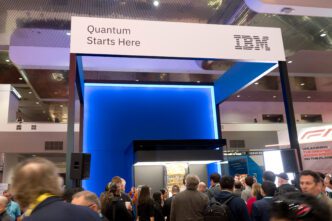Executive Summary
The Story So Far
Why This Matters
Who Thinks What?
IBM has unveiled a significant advancement in its quantum computing roadmap, introducing the Nighthawk and experimental Loon processors, alongside upgraded software and fabrication methods. These developments aim to achieve a “community-verified quantum advantage” by 2026 and critical milestones towards fault tolerance by 2029, pushing the industry closer to commercially viable quantum machines.
New Quantum Processors Unveiled
The new Nighthawk processor features 120 qubits and 218 tunable couplers, an increase of approximately 20% over IBM’s previous Heron design. This enhanced architecture allows for circuits roughly 30% more complex, supporting computations with up to 5,000 two-qubit gates. The first Nighthawk systems are anticipated to reach users by late 2025, with future iterations projected to exceed 1,000 connected qubits by 2028.
Concurrently, IBM announced progress on its experimental Quantum Loon processor, which integrates key hardware components essential for fault-tolerant quantum computing. This includes long-range “c-couplers” for linking distant qubits and the capability to reset qubits between operations. The company reported a tenfold speedup in error-decoding performance, achieving real-time correction in under 480 nanoseconds using qLDPC codes, a milestone reached ahead of schedule.
Implications for Bitcoin Security
While IBM’s progress brings “Q-Day”—the theoretical moment a quantum computer could break current encryption—closer, the new processors are still far from posing an immediate threat to Bitcoin’s elliptic curve cryptography. Cracking Bitcoin’s security would necessitate a fault-tolerant quantum computer equipped with approximately 2,000 logical qubits, translating to tens of millions of physical qubits once error correction is implemented.
These developments follow a period of renewed interest and investment in quantum computing. In October, Google’s Willow processor achieved a verified quantum speed-up in a physics simulation, a result that reignited discussions about the long-term security of Bitcoin’s encryption.
Software and Manufacturing Innovations
IBM is also enhancing its quantum software, Qiskit, to complement the new hardware. Dynamic circuits in Qiskit have reportedly improved accuracy by 24% at the 100-qubit scale. A new C-API interface connects Qiskit with high-performance classical systems, accelerating error mitigation and reducing the cost of extracting accurate results by over 100 times, according to IBM. By 2027, the company plans to integrate computational libraries for machine learning and optimization to aid in modeling physical and chemical systems.
To accelerate development and production, IBM has relocated the manufacturing of its quantum chips to a 300-millimeter wafer line at the Albany NanoTech Complex in New York. This strategic move has doubled research speed, increased chip complexity tenfold, and enabled the parallel development and exploration of multiple processor designs.
Paving the Way for Scalable Quantum Systems
These updates represent ongoing progress toward IBM’s goal of delivering a large-scale, fault-tolerant quantum computer, dubbed IBM Quantum Starling, by 2029. Reaching this objective for industrial use requires substantial advancements in modular architecture and error correction. Jay Gambetta, IBM Research Director, stated, “We believe that IBM is the only company that is positioned to rapidly invent and scale quantum software, hardware, fabrication, and error correction to unlock transformative applications.”







